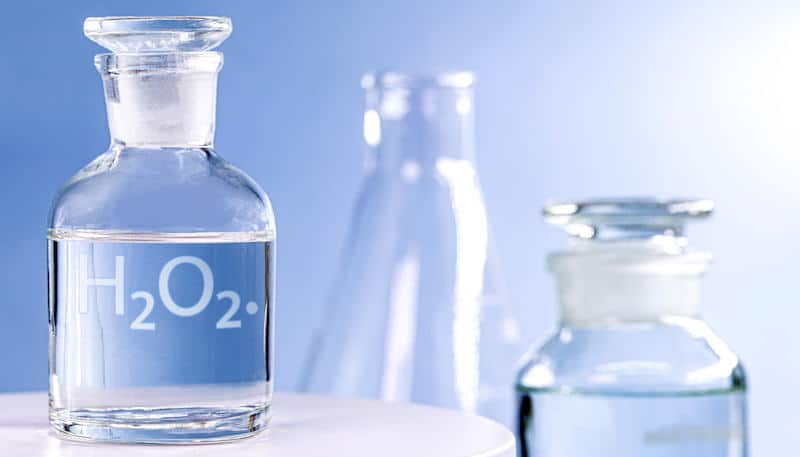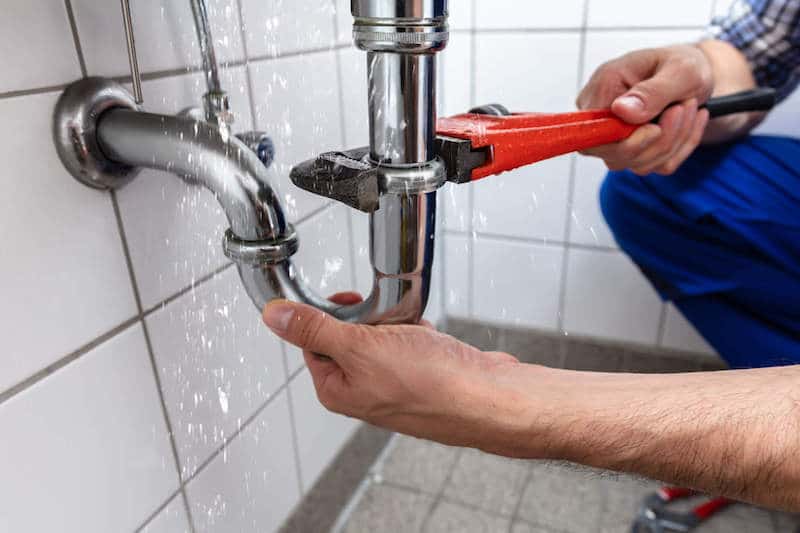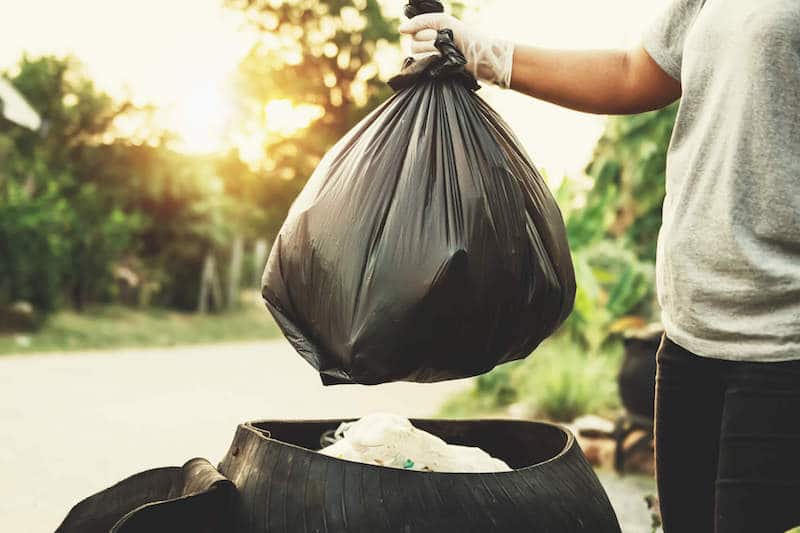Most of us are probably familiar with hydrogen peroxide: the bubbly disinfectant our parents poured over booboos that created an immediate sting and a giant puddle of fizz. At the time, it was painful magic. Now, we know that this magical product is a killer disinfectant (ahh, the beauty of a pun) and helps eliminate viruses and bacteria. As we’ve gotten older, though, we’ve heard how this wonder-product isn’t just an option for cleaning wounds- it’s versatile. At some point or another, you’ve probably asked the question (thanks to pop culture), “Does hydrogen peroxide get rid of mold?”
It’s not a bad question! Hydrogen peroxide is non-toxic. It’s inexpensive… It sounds like it would be the perfect mold remediation solution to ensure your indoor environment is safe and free from moldy contamination.
So. Does hydrogen peroxide get rid of mold? Yes, it sure does! Even the CDC says so.¹
Here’s why and how to utilize it properly.
WHAT EVEN IS MOLD?
To better answer the question, “Does hydrogen peroxide remove mold?” it’s best to understand what you’re attempting to remove in the first place and why you should remove it. Correctly.
Mold is a type of fungus with over 100,000 species identified so far by researchers across the world.²’³ The term “mold” could be referencing a few things, which is a big contributor to the misinformation out there regarding this fungus among us.
TALKING ABOUT MOLD COULD MEAN:
- The umbrella term for the over 100,000 fungi species.
- The particle
- The organism
This fungus is very similar to a plant. To reproduce, colonized mold creates microscopic spores and releases them into the air. These are the non-living particle portion of a mold’s life cycle. The process is incredibly similar to how a plant reproduces by creating seeds. Picture a dandelion puff releasing those fluffy white blobs out into nature.
Likewise, spores will ride the air current to wherever that leads, sometimes right through your front door. These little particles don’t cause a problem as long as you actively remove them and if they don’t find a nice little place to settle in and start to grow.

If the spore lands on a habitable surface with the components it needs to grow, it will transition into a living organism. Again, picture a seed. In order to transition into a live plant, a seed needs an environment that provides things like nutrients and water. Otherwise, it will remain a seed forever. Spores, likewise, will remain non-living particles unless they stumble on a liveable surface, which can often occur in a home.
If the spore lands on a habitable surface with the components it needs to grow, it will transition into a living organism. Again, picture a seed. In order to transition into a live plant, a seed needs an environment that provides things like nutrients and water. Otherwise, it will remain a seed forever. Spores, likewise, will remain non-living particles unless they stumble on a liveable surface, which can often occur in a home.
MOLD IN THE HOME
Give a spore a little oxygen, a temperature-controlled environment, food (they eat almost anything, even dust), and a bit of moisture for 24-48 hours and it’ll put down roots and begin to grow.⁴ Once it’s established in a home, the new mold colony will begin to produce more spores, filling the space with contaminants, and lowering the indoor air quality. Some species of mold can also produce microscopic toxins called mycotoxins, another particle contaminating the indoor space.⁵
Hence, why asking, “Does peroxide get rid of mold?” is a phenomenal question; once that fungus starts growing inside, it needs to be handled quickly and correctly to limit the contamination and length of exposure time.
DOES HYDROGEN PEROXIDE GET RID OF MOLD? WHY THE ANSWER MATTERS
With so many species of mold existing in the world and this fungus needing so little to survive and thrive, it’s impossible to completely avoid coming in contact with moldy particles completely. You probably encounter a few spores throughout the day just walking into work, driving down the road, or hanging out in your kitchen.
Typically, coming across a few spores doesn’t cause a problem. Your immune system will identify them as foreign invaders and get rid of them ASAP. When a mold colony lives in your home, though, you’re not just encountering a few random particles. The growing mold fills the indoor space with spores (and sometimes toxins), forcing your body to battle an army of particles every time you’re hanging out inside. Eventually, the immune system can get bogged down and malfunction, leading to a list of possible symptoms.

SYMPTOMS OF MOLD EXPOSURE CAN INCLUDE:
- Runny nose
- Watery eyes
- Rashes
- Neurological problems
- Coughing
- Brain fog
- Respiratory issues
- Chronic fatigue
- Hair loss
- Digestive issues
Researchers are still attempting to determine exactly how mold affects the body, but everyone responds to exposure differently. Factors such as genetics, immune system status, species of mold, presence of mycotoxins, and length of exposure all play a role, making it a difficult issue to nail down. ⁶’⁷’⁸’⁹’¹⁰
The potential for symptoms is why it’s important to answer the question, “Does hydrogen peroxide get rid of mold,” and how to use this method correctly.
DOES HYDROGEN PEROXIDE GET RID OF MOLD? YES, AND HERE’S WHY
Misinformation and lack of understanding when it comes to mold triggered a bit of an issue when it came to remediation. Unless the right products and procedures are followed, contaminants can be left behind and allow for exposure to continue. Prolonged exposure leads to continued and worsening symptoms so this scenario is a moldy no-no.
So, what are the right products for mold removal? You’ll want items that not only kill mold but pull it up by the roots so that you can wipe it away. It’s also a good idea to go with non-toxic products, as harsh chemicals can trigger certain species of mold into releasing mycotoxins.
One such product that ticks every one of those boxes happens to be hydrogen peroxide.

SO, WHAT IS HYDROGEN PEROXIDE?
This antiseptic product is a liquid composed of water with an extra oxygen molecule.¹¹ That additional oxygen atom provides hydrogen peroxide with its magical and powerful oxidation powers. In a nutshell, oxidation refers to a chemical reaction where an electron is pulled from an atom or molecule, changing its composition.¹²
When it comes to hydrogen peroxide’s disinfectant properties, oxidizing things such as bacteria and viruses break down the cellular membrane of the microorganisms and essentially kill them.¹³ That’s why it’s such a great multipurpose product to get rid of unwanted contaminants.
HOW DOES HYDROGEN PEROXIDE GET RID OF MOLD?
Like with bacteria and viruses, hydrogen peroxide oxidizes the mold once they come into contact, breaking down the cellular structure of the fungus and inhibiting growth.¹⁴ While decomposing the mold, it also lifts particles to the surface which is key because of those moldy roots. Other products, such as bleach, will not help lift mold by the roots, leaving a majority of the particles and contamination behind.
Again, that’s a contamination and exposure nightmare we want to avoid. The key to proper removal that works is to get rid of all of the particles so that the surface is completely clean.
WHY HYDROGEN PEROXIDE?
Lots of reasons, including the ones already listed above.
HERE ARE A FEW OTHERS TO REALLY CONVINCE YOU:
- If bacteria is present from the source of the water, it will kill these microorganisms too
- It’s non-toxic, unlike other harsh chemicals like bleach
- Penetrates semi-porous surfaces (bleach does not)¹⁵
- Can be safely used on most surfaces
- Inexpensive
- Does not create byproducts that are harmful to the environment
Essentially, it’s just a great tool to use in the fight against mold.

DOES HYDROGEN PEROXIDE GET RID OF MOLD? OBVIOUSLY, NOW HERE’S HOW TO GET STARTED
First things first, determine which surface you’re working with. Keep in mind as well that any remediation project you tackle yourself should only include a small area of mold. For larger issues, it’s best to call in a remediation team that can properly handle the situation.
Also, along with getting rid of all of the contamination, the source that led to the moldy problem needs to be fixed. For instance, if there’s a leak that led to a bit of mold growth, that needs to be taken care of to ensure the mold doesn’t just grow right back.
But, back to the surfaces.
SURFACE TYPES INCLUDE:
- Porous: liquid absorbs into them, such as clothing, lampshades, and carpet
- Non-porous: liquid pools on top of them, such as finished wood, sealed countertops, and glass
- Semi-porous: some liquid pools on top and some seeps into it, such as unsealed wood, leather furniture, and some plastic
BREAKING IT DOWN BY SURFACE
When it comes to remediation, all porous materials should be removed and replaced. You can attempt to decontaminate them, but the moldy particles can make their way deep into the fibers and be almost impossible to remove. Since prolonged exposure to the contamination can impact your health, the safest option is to just start fresh.

For non-porous surfaces, it’s easiest to just thoroughly remediate with a botanical disinfectant like Benefect Decon 30. The roots of the mold cannot penetrate deep down, leading to the easiest removal. Spray, wipe, HEPA vacuum, repeat, and poof, clean surface.
That leaves semi-porous surfaces as the go-to for hydrogen peroxide. With powerful oxidation powers, this wonder-mold remediator can help pull particles up to the top of the surface and assist in complete decontamination.
A good rule of thumb is to seal any semi-porous surfaces after remediation for further protection against this fungus among us.
USING HYDROGEN PEROXIDE
Now that you’ve got the answer to, “Does hydrogen peroxide get rid of mold,” and you know you’re working with the ideal surface, here’s how to get started on remediation.
THE SUPPLIES
- Hydrogen peroxide: Opt for 8%, it’s the best!
- A spray bottle: You’ll transfer the peroxide into this container.
- Microfiber towels: These are 100 times better at removing particles than regular towels.
- HEPA vacuum cleaner: This machine will remove at least 99.7% of particles up to 0.3 microns in size (the smaller it can remove, the better).¹⁵
- Protective gear: A mask and gloves help limit exposure from particles getting kicked up by the remediation.
THE PROCESS
- Pour the hydrogen peroxide into the spray bottle
- Spray the surface and allow the peroxide to sit for at least 10 minutes
- Wipe the surface with a microfiber towel
- HEPA vacuum the surface thoroughly
- Complete a final wipe down of the surface with the microfiber towel
After disinfecting, allow the surface to dry completely and consider sealing it if possible.
Make sure to keep a close eye on the surface after you finish remediating the mold. Does hydrogen peroxide get rid of mold? Yes, but if the fungus comes back quickly, there could be a bigger problem at hand that requires professional help. You can attempt to remediate again, but the better option is to call in a mold inspector to make sure there’s not a hidden issue.

MAINTAINING A SAFE ENVIRONMENT
We don’t always consider how safe our indoor spaces are, but we should! On average, we breathe in 20,000 breaths a day and most of those are probably taken right within our own home.¹⁶ If that space is filled with harmful particles like mold spores and toxins, our health will suffer the consequences.
Knowing how to remediate mold and which products are best to use helps ensure that your indoor space is safe for you and your family. So, if anyone asks you, “Does hydrogen peroxide get rid of mold?” you can confidently say yes. Here’s why, and here’s how! The more mold awareness we have and share with others, the safer and healthier our lives will be.
Still Have Questions?
A member of our team is here to help! Click on “Get Started ➤” below to book a consultation with a member of the HOMECLEANSE team. We have a few quick questions that will help us put together a roadmap to solve or prevent all of your mold problems.
Two minutes of your time could lead to better health for you and your family.
- CDC Staff. (2016, September 18). Chemical disinfectants. Centers for Disease Control and Prevention. Retrieved February 17, 2022, from https://www.cdc.gov/infectioncontrol/guidelines/disinfection/disinfection-methods/chemical.html#Hydrogen
- Environmental Protection Agency. (n.d.). Mold. EPA. Retrieved from https://www.epa.gov/mold.
- Centers for Disease Control and Prevention. Basic facts about mold and dampness. Centers for Disease Control and Prevention. Retrieved from https://www.cdc.gov/mold/faqs.htm.
- Lstiburek, J., Brennan, T., & Yost, N. (2002, January 15). Rr-0208: What you need to know about mold. Building Science Corporation. Retrieved from, https://www.buildingscience.com/documents/reports/rr-0208-what-you-need-to-know-about-mold/view.
- World Health Organization. (n.d.). Mycotoxins. World Health Organization. Retrieved from https://www.who.int/news-room/fact-sheets/detail/mycotoxins.
- Environmental and Occupational Health Assessment Program, & Environmental and Occupational Health Assessment Program, & Health Science Section, Mold Basics for Primary Care Clinicians (2009). Hartford, CT; Connecticut Department of Public Health. , H. S. S., Mold Basics for Primary Care Clinicians 1–10 (2009). Hartford, CT; Connecticut Department of Public Health.
- Curtis, L., Lieberman, A., Stark, M., Rea, W., & Vetter, M. (2004). Adverse health effects of indoor molds. Journal of Nutritional & Environmental Medicine, 14(3), 261-274.
- Bush, R. K., Portnoy, J. M., Saxon, A., Terr, A. I., & Wood, R. A. (2006). The medical effects of mold exposure. Journal of Allergy and Clinical Immunology, 117(2), 326-333
- Fisk, W. J., Lei-Gomez, Q., & Mendell, M. J. (2007). Meta-analyses of the associations of respiratory health effects with dampness and mold in homes. Indoor air, 17(4), 284-296.
- Wild, C. P., & Gong, Y. Y. (2010). Mycotoxins and human disease: a largely ignored global health issue. Carcinogenesis, 31(1), 71-82.
- Cleveland Clinic Staff. (2021, December 2). Hydrogen peroxide: How to use it properly. Cleveland Clinic. Retrieved February 17, 2022, from https://health.clevelandclinic.org/what-is-hydrogen-peroxide-good-for/
- ScienceDirect Staff. (n.d.). Oxidation. ScienceDirect. Retrieved February 17, 2022, from https://www.sciencedirect.com/topics/earth-and-planetary-sciences/oxidation
- Zhu, G., Wang, Q., Lu, S., & Niu, Y. (2017). Hydrogen Peroxide: A Potential Wound Therapeutic Target?. Medical principles and practice : international journal of the Kuwait University, Health Science Centre, 26(4), 301–308. https://doi.org/10.1159/000475501
- Chakravarty, P., & Kovar, B. (2013). Engineering case report: evaluation of five antifungal agents used in remediation practices against six common indoor fungal species. Journal of occupational and environmental hygiene, 10(1), D11-D16.
Chicago - EPA. (n.d.). Should I use bleach to clean up mold? EPA. Retrieved from https://www.epa.gov/mold/should-i-use-bleach-clean-mold.
- EPA. (n.d.). What is a HEPA filter? EPA. Retrieved from https://www.epa.gov/indoor-air-quality-iaq/what-hepa-filter-1.
- Brown, A. (2014, April 28). How Many Breaths Do You Take Each Day? [web log]. Retrieved November 16, 2021, from How Many Breaths Do You Take Each Day?







